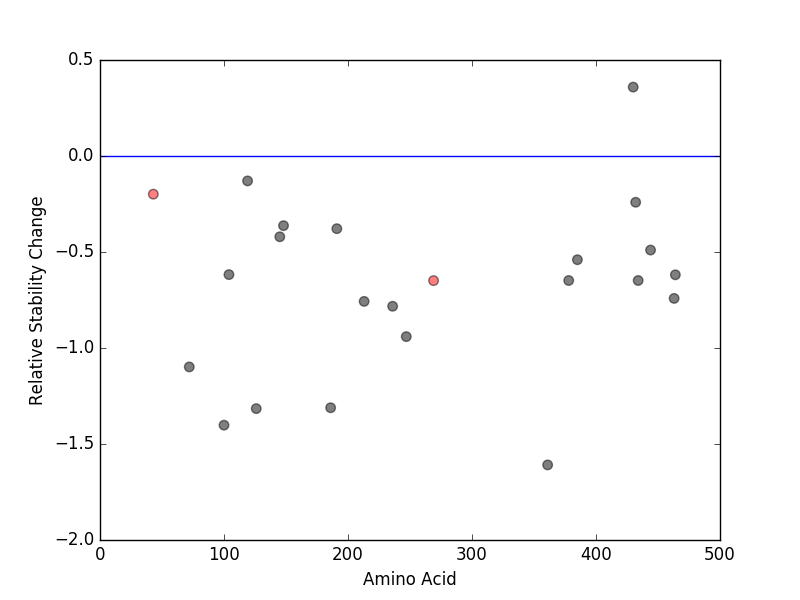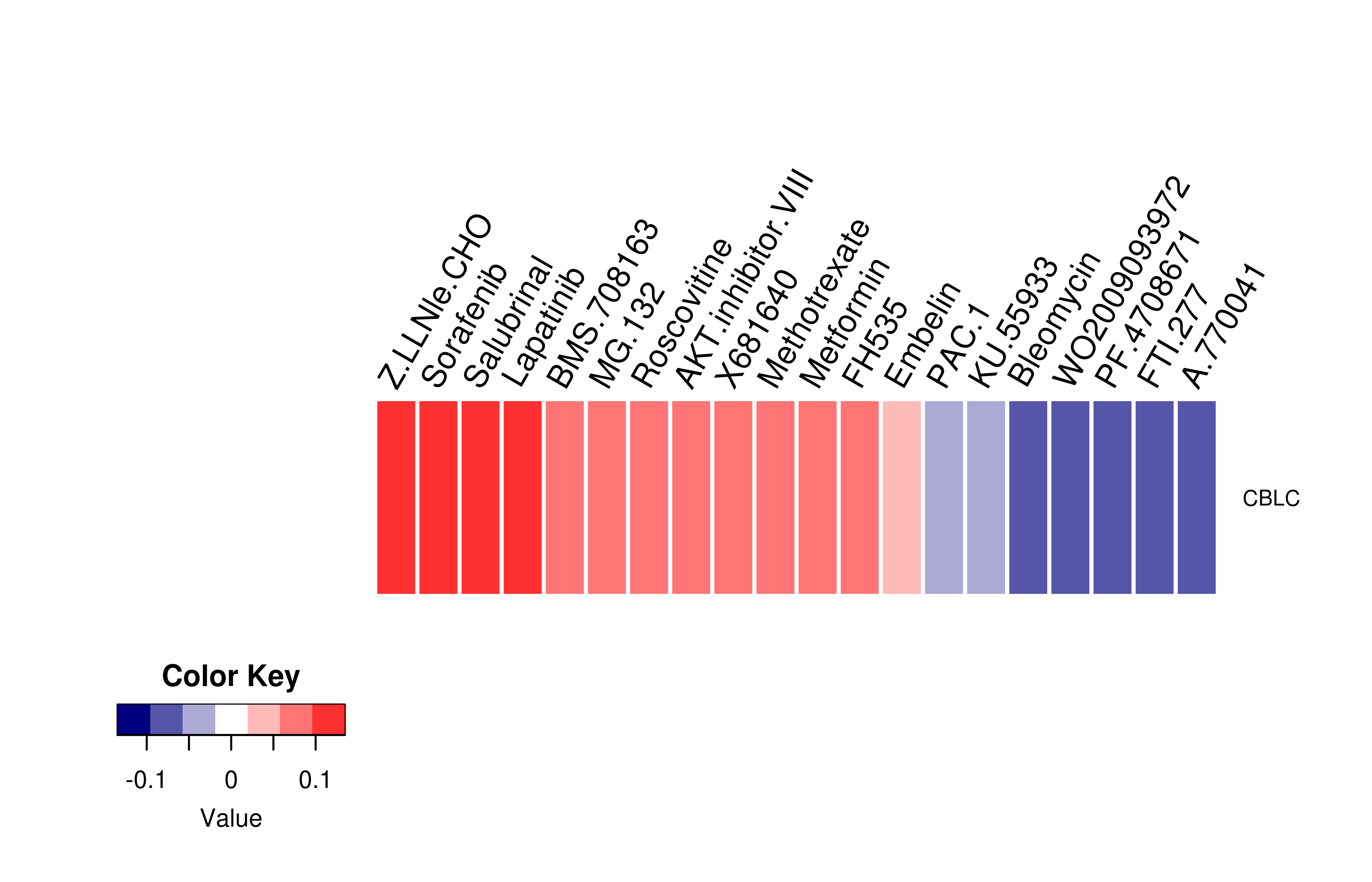mutLBSgeneDB
|
mutLBSgeneDB
mutated Ligand Binding Site gene DataBase
|
 Gene summary Gene summary |
 Gene ontology having evidence of Inferred from Direct Assay (IDA) from Entrez Gene ontology having evidence of Inferred from Direct Assay (IDA) from Entrez |
| GO ID | GO Term | PubMed ID |
GO:0007175 | negative regulation of epidermal growth factor-activated receptor activity | 10362357 | GO:0042059 | negative regulation of epidermal growth factor receptor signaling pathway | 10362357 | GO:0042787 | protein ubiquitination involved in ubiquitin-dependent protein catabolic process | 14661060 | GO:0043407 | negative regulation of MAP kinase activity | 10362357 |
 Lollipop-style diagram of mutations at LBS in amino-acid sequence. Lollipop-style diagram of mutations at LBS in amino-acid sequence.
We represented ligand binding site mutations only. (You can see big image via clicking.)
 : non-synonymous mutation on LBS, Circle size denotes number of samples. : non-synonymous mutation on LBS, Circle size denotes number of samples. |
 Cancer type specific mutLBS sorted by frequency Cancer type specific mutLBS sorted by frequency |
| LBS | AAchange of nsSNV | Cancer type | # samples |
P41 | S43L | SKCM | 1 | T268 | R269C | UCEC | 1 |
| cf) Cancer type abbreviation. BLCA: Bladder urothelial carcinoma, BRCA: Breast invasive carcinoma, CESC: Cervical squamous cell carcinoma and endocervical adenocarcinoma, COAD: Colon adenocarcinoma, GBM: Glioblastoma multiforme, LGG: Brain lower grade glioma, HNSC: Head and neck squamous cell carcinoma, KICH: Kidney chromophobe, KIRC: Kidney renal clear cell carcinoma, KIRP: Kidney renal papillary cell carcinoma, LAML: Acute myeloid leukemia, LUAD: Lung adenocarcinoma, LUSC: Lung squamous cell carcinoma, OV: Ovarian serous cystadenocarcinoma, PAAD: Pancreatic adenocarcinoma, PRAD: Prostate adenocarcinoma, SKCM: Skin cutaneous melanoma, STAD: Stomach adenocarcinoma, THCA: Thyroid carcinoma, UCEC: Uterine corpus endometrial carcinoma. |
 Relative protein structure stability change (ΔΔE) using Mupro 1.1 Relative protein structure stability change (ΔΔE) using Mupro 1.1
Mupro score denotes assessment of the effect of mutations on thermodynamic stability.
(ΔΔE<0: mutation decreases stability, ΔΔE>0: mutation increases stability) |
 : nsSNV at non-LBS : nsSNV at non-LBS : nsSNV at LBS : nsSNV at LBS |
 nsSNVs sorted by the relative stability change of protein structure by each mutation nsSNVs sorted by the relative stability change of protein structure by each mutation
Blue: mutations of positive stability change. and red : the most recurrent mutation for this gene. |
| LBS | AAchange of nsSNV | Relative stability change |
T268 | R269C | -0.64901458 | P41 | S43L | -0.19875254 |
| (MuPro1.1: Jianlin Cheng et al., Prediction of Protein Stability Changes for Single-Site Mutations Using Support Vector Machines, PROTEINS: Structure, Function, and Bioinformatics. 2006, 62:1125-1132) |
 Structure image for CBLC from PDB Structure image for CBLC from PDB |
 Differential gene expression between mutated and non-mutated LBS samples in all 16 major cancer types Differential gene expression between mutated and non-mutated LBS samples in all 16 major cancer types |
 Differential co-expressed gene network based on protein-protein interaction data (CePIN) Differential co-expressed gene network based on protein-protein interaction data (CePIN) |
 Gene level disease information (DisGeNet) Gene level disease information (DisGeNet) |
| Disease ID | Disease name | # PubMed | Association type |
| Allele ID | AA change | Clinical significance | Origin | Phenotype IDs |
 Gene expression profile of anticancer drug treated cell-lines (CCLE) Gene expression profile of anticancer drug treated cell-lines (CCLE)
Heatmap showing the correlation between gene expression and drug response across all the cell-lines. We chose the top 20 among 138 drugs.We used Pearson's correlation coefficient. |
 Drug information targeting mutLBSgene (Approved drugs only) Drug information targeting mutLBSgene (Approved drugs only) |
| Drug status | DrugBank ID | Name | Type | Drug structure |
 Gene-centered ligand-gene interaction network Gene-centered ligand-gene interaction network |
 Ligands binding to mutated ligand binding site of CBLC go to BioLip Ligands binding to mutated ligand binding site of CBLC go to BioLip |
| Ligand ID | Ligand short name | Ligand long name | PDB ID | PDB name | mutLBS |
III | | Peptide ligand (LEU,GLN,ARG,TYR,SER,SER,ASP,PRO,THR,GLY) | 3op0 | A | P41 T268 | III | | Peptide ligand (LEU,GLN,ARG,TYR,SER,SER,ASP,PRO,THR,GLY) | 3op0 | B | P41 T268 | III | | Peptide ligand (ASN,GLU,TYR,THR,ALA) | 3vro | A | P41 T268 | III | | Peptide ligand (GLN,ARG,TYR,SER,SER,ASP,PRO,THR) | 3vrp | A | P41 T268 | III | | Peptide ligand (GLN,ARG,TYR,SER,SER,ASP,PRO,THR) | 3vrr | A | P41 T268 |
 Multiple alignments for Q9ULV8 in multiple species Multiple alignments for Q9ULV8 in multiple species |
| LBS | AA sequence | # species | Species |
A274 | RLGQWAIGYVS | 3 | Homo sapiens, Mus musculus, Rattus norvegicus | C267 | IFRPSCTRLGQ | 3 | Homo sapiens, Mus musculus, Rattus norvegicus | D199 | LRTTIDLTCSG | 1 | Homo sapiens | D199 | LRSTLDLTCNG | 1 | Mus musculus | D199 | LRSTLDLTCSG | 1 | Rattus norvegicus | D304 | LEGQKDGFYLY | 1 | Homo sapiens | D304 | LKGQKDGIFLF | 1 | Mus musculus | D304 | LKGQKDGIFLY | 1 | Rattus norvegicus | E210 | HVSIFEFDVFT | 1 | Homo sapiens | E210 | HVSVFEFDVFT | 1 | Mus musculus | E210 | HVSVFEFDIFT | 1 | Rattus norvegicus | E300 | LQVLLKGQKDG | 2 | Mus musculus, Rattus norvegicus | E300 | SQVLLEGQKDG | 1 | Homo sapiens | F306 | GQKDGFYLYPD | 1 | Homo sapiens | F306 | GQKDGIFLFPD | 1 | Mus musculus | F306 | GQKDGIFLYPD | 1 | Rattus norvegicus | G301 | QVLLKGQKDGI | 2 | Mus musculus, Rattus norvegicus | G301 | QVLLEGQKDGF | 1 | Homo sapiens | H205 | LTCSGHVSIFE | 1 | Homo sapiens | H205 | LTCNGHVSVFE | 1 | Mus musculus | H205 | LTCSGHVSVFE | 1 | Rattus norvegicus | I288 | SILQTIPLNKP | 2 | Mus musculus, Rattus norvegicus | I288 | SILQTIPANKP | 1 | Homo sapiens | K292 | TIPLNKPLLQV | 2 | Mus musculus, Rattus norvegicus | K292 | TIPANKPLSQV | 1 | Homo sapiens | L285 | SDGSILQTIPA | 1 | Homo sapiens | L285 | SDGSILQTIPL | 1 | Mus musculus | L285 | SNGSILQTIPL | 1 | Rattus norvegicus | P41 | RLSVSPPSLRD | 1 | Homo sapiens | P41 | RMVTGPPSLRD | 1 | Mus musculus | P41 | RLFVGPPSLRD | 1 | Rattus norvegicus | Q286 | DGSILQTIPAN | 1 | Homo sapiens | Q286 | DGSILQTIPLN | 1 | Mus musculus | Q286 | NGSILQTIPLN | 1 | Rattus norvegicus | R264 | GSYIFRPSCTR | 3 | Homo sapiens, Mus musculus, Rattus norvegicus | S203 | IDLTCSGHVSI | 1 | Homo sapiens | S203 | LDLTCNGHVSV | 1 | Mus musculus | S203 | LDLTCSGHVSV | 1 | Rattus norvegicus | S266 | YIFRPSCTRLG | 3 | Homo sapiens, Mus musculus, Rattus norvegicus | S40 | PRLSVSPPSLR | 1 | Homo sapiens | S40 | PRMVTGPPSLR | 1 | Mus musculus | S40 | LRLFVGPPSLR | 1 | Rattus norvegicus | T201 | TTIDLTCSGHV | 1 | Homo sapiens | T201 | STLDLTCNGHV | 1 | Mus musculus | T201 | STLDLTCSGHV | 1 | Rattus norvegicus | T268 | FRPSCTRLGQW | 3 | Homo sapiens, Mus musculus, Rattus norvegicus | T287 | GSILQTIPLNK | 2 | Mus musculus, Rattus norvegicus | T287 | GSILQTIPANK | 1 | Homo sapiens | Y244 | MAFLTYDEVQT | 2 | Mus musculus, Rattus norvegicus | Y244 | MAFLTYDEVQE | 1 | Homo sapiens | Y277 | QWAIGYVSSDG | 2 | Homo sapiens, Mus musculus | Y277 | QWAIGYVSSNG | 1 | Rattus norvegicus | Y307 | QKDGFYLYPDG | 1 | Homo sapiens | Y307 | QKDGIFLFPDG | 1 | Mus musculus | Y307 | QKDGIFLYPDG | 1 | Rattus norvegicus |
 Gene summary
Gene summary  Gene ontology having evidence of Inferred from Direct Assay (IDA) from Entrez
Gene ontology having evidence of Inferred from Direct Assay (IDA) from Entrez  Lollipop-style diagram of mutations at LBS in amino-acid sequence.
Lollipop-style diagram of mutations at LBS in amino-acid sequence. 
 Cancer type specific mutLBS sorted by frequency
Cancer type specific mutLBS sorted by frequency Relative protein structure stability change (ΔΔE) using Mupro 1.1
Relative protein structure stability change (ΔΔE) using Mupro 1.1  : nsSNV at non-LBS
: nsSNV at non-LBS : nsSNV at LBS
: nsSNV at LBS
 nsSNVs sorted by the relative stability change of protein structure by each mutation
nsSNVs sorted by the relative stability change of protein structure by each mutation  Structure image for CBLC from PDB
Structure image for CBLC from PDB Differential gene expression between mutated and non-mutated LBS samples in all 16 major cancer types
Differential gene expression between mutated and non-mutated LBS samples in all 16 major cancer types Differential co-expressed gene network based on protein-protein interaction data (CePIN)
Differential co-expressed gene network based on protein-protein interaction data (CePIN) Gene level disease information (DisGeNet)
Gene level disease information (DisGeNet)  Mutation level pathogenic information (ClinVar annotation)
Mutation level pathogenic information (ClinVar annotation)  Gene expression profile of anticancer drug treated cell-lines (CCLE)
Gene expression profile of anticancer drug treated cell-lines (CCLE)
 Drug information targeting mutLBSgene (Approved drugs only)
Drug information targeting mutLBSgene (Approved drugs only) Gene-centered ligand-gene interaction network
Gene-centered ligand-gene interaction network 
 Ligands binding to mutated ligand binding site of CBLC go to BioLip
Ligands binding to mutated ligand binding site of CBLC go to BioLip Multiple alignments for Q9ULV8 in multiple species
Multiple alignments for Q9ULV8 in multiple species 
